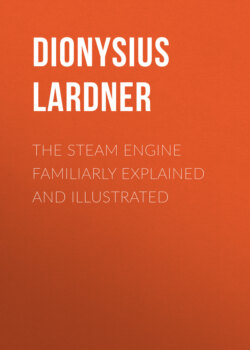Читать книгу The Steam Engine Familiarly Explained and Illustrated - Dionysius Lardner - Страница 12
На сайте Литреса книга снята с продажи.
DENIS PAPIN, 1695.
ОглавлениеTable of Contents
(29.) Denis Papin, a native of Blois in France, and professor of mathematics at Marbourg, had been engaged about this period in the contrivance of a machine in which the atmospheric pressure should be made available as a mechanical agent by creating a partial vacuum in a cylinder under a piston. His first attempts were directed to the production of this vacuum by mechanical means, having proposed to apply a water-wheel to work an air-pump, and so maintain the degree of rarefaction required. This, however, would eventually have amounted to nothing more than a mode of transmitting the power of the water-wheel to another engine, since the vacuum produced in this way could only give back the power exerted by the water-wheel diminished by the friction of the pumps; still this would attain the end first proposed by Papin, which was merely to transmit the force of the stream of a river, or a fall of water, to a distant point, by partially exhausted pipes or tubes. He next, however, attempted to produce a partial vacuum by the explosion of gunpowder; but this was found to be insufficient, since so much air remained in the cylinder under the piston, that at least half the power due to a vacuum would have been lost. "I have, therefore," proceeds Papin, "attempted to attain this end by another method. Since water being converted into steam by heat acquires the property of elasticity like air, and may afterwards be recondensed so perfectly by cold that there will no longer remain the appearance of elasticity in it, I have thought that it would not be difficult to construct machines in which, by means of a moderate heat, and at a small expense, water would produce that perfect vacuum which has been vainly sought by means of gunpowder."
Papin accordingly constructed the model of a machine, consisting of a small pump, in which was placed a solid piston, and in the bottom of the cylinder under the piston was contained a small quantity of water. The piston being in immediate contact with this water, so as to exclude the atmospheric air, on applying fire to the bottom of the cylinder steam was produced, the elastic force of which raised the piston to the top of the cylinder: the fire being then removed, and the cylinder being cooled by the surrounding air, the steam was condensed and reconverted into water, leaving a vacuum in the cylinder into which the piston was pressed by the force of the atmosphere. The fire being applied and subsequently removed, another ascent and descent were accomplished; and in the same manner the alternate motion of the piston might be continued. Papin described no other form of machine by which this property could be rendered available in practice; but he states generally that the same end may be attained by various forms of machines easy to be imagined.[6]
